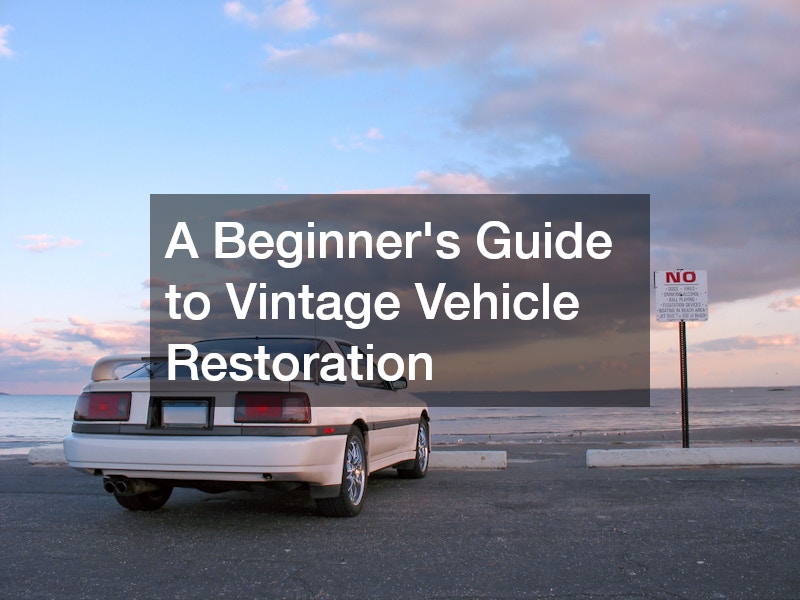A Beginners Guide to Vintage Vehicle Restoration
by Car magazines · Published · Updated


Restoring a vintage vehicle is both a rewarding and challenging journey. For many car enthusiasts, bringing a classic car back to life combines passion with craftsmanship, turning a project into a valuable and beautiful piece of history. Whether you’re starting with a rusted shell or a vehicle that needs some updates, understanding the steps involved in restoration is essential to success. In this beginner’s guide, we’ll walk you through the stages of restoring a vintage vehicle, covering everything from the initial assessment to the final touches.
Assessing the Vehicle’s Condition

Before diving into the restoration process, it’s crucial to assess the current condition of your vintage vehicle. This initial step helps you understand the scope of the project and determine whether it’s worth the investment. Start by thoroughly inspecting the car from top to bottom.
-
Exterior Inspection: Look for rust, dents, and other signs of wear on the body. Rust is particularly troublesome in vintage cars and can weaken the vehicle’s structural integrity if left untreated. Scrutinize the undercarriage, wheel wells, and doors, as these are common spots for rust to develop. Depending on the extent of the damage, you may need to contact an automotive restoration company to restore the body.
-
Interior Inspection: Check the condition of the seats, dashboard, and any original features such as wood paneling or vintage radio systems. The cost to restore these elements can vary, but keeping the interior as close to its original condition as possible will add to the car’s value.
-
Mechanical Components: Investigate the state of the engine, transmission, and brakes. While some older cars have engines that can be salvaged and repaired, you may need to consider engine replacements if the existing one is beyond repair. This is also the time to consider performance transmissions if you want to upgrade the car for better driving efficiency.
After conducting a thorough visual and mechanical inspection, an auto inspection service can provide a more in-depth analysis of what needs to be repaired, replaced, or restored. This service can help you estimate the time and cost involved, giving you a clearer picture of your restoration journey.
Planning the Restoration

Once you have assessed the vehicle, the next step is to develop a detailed plan for the restoration process. This includes outlining what parts need to be restored, replaced, or upgraded. Here’s a general guide for organizing your project:
-
Set Goals: Are you aiming for a full restoration to original factory condition, or are you adding custom elements like modern upgrades? For example, you might want to install auto anti theft GPS tracking to enhance security for your valuable vintage car. Defining your goals will help guide decisions throughout the process.
-
Establish a Budget: Restoring vintage vehicles can be expensive, so it’s essential to set a budget early on. Keep in mind that unplanned repairs, such as rust removal or structural repairs, can quickly increase the costs. Make sure to budget for labor, parts, paint, and upgrades like heating systems or modern safety features.
-
Identify Resources: Determine whether you will perform the restoration yourself or hire professionals. For instance, if the car’s engine needs significant repairs, you might want to bring in experts to handle the more technical aspects like engine replacements or brake repairs. Research local experts who specialize in vintage cars and consider partnering with an automotive restoration company if the project seems overwhelming.
Sourcing Parts and Tools
A major part of restoring a vintage vehicle is sourcing authentic parts that match the car’s original specifications. The more original parts you can use in the restoration, the more valuable the car will be. However, finding these parts can be tricky, especially for rare models.
-
Original vs. Aftermarket Parts: Some car owners prefer to use only original manufacturer parts (OEM) to maintain the vehicle’s authenticity. However, OEM parts for vintage cars can be difficult to find and expensive. In these cases, aftermarket parts offer a more affordable alternative. Depending on your restoration goals, you might choose a mix of both to stay within your budget.
-
Specialized Tools: Restoring a car requires more than just basic tools. You’ll need specialized equipment for tasks like removing rust, disassembling and reassembling the engine, or installing new tires and suspension components. If you’re planning on doing most of the work yourself, investing in high-quality tools will be critical to your success.
-
Finding a Lexus Repair Service: If you’re restoring a vintage Lexus or a luxury car, you’ll need to find a Lexus repair service that specializes in these vehicles. These experts will have access to authentic parts and understand the specific needs of high-end vehicles, ensuring that your restoration maintains the value and integrity of the original car.
Restoring the Body and Paint

One of the most visible aspects of a vintage vehicle restoration is the exterior. Restoring the body and paint is often the first major step after disassembling the car.
-
Rust Removal: Rust is one of the biggest threats to vintage cars, especially those stored in humid climates. You’ll need to remove rust carefully, ensuring that it doesn’t return after the restoration. If the rust damage is extensive, sections of the car’s body may need to be cut out and replaced with new panels.
-
Body Work: Once rust removal is complete, any dents or other damage must be repaired. Skilled professionals at an automotive restoration company can use techniques like metal shrinking or filler to smooth out the body. Auto dent repairs and frame straightening may also be necessary to restore the car’s structure.
-
Painting: After the body is repaired, it’s time to focus on the paint job. Many car enthusiasts aim to match the original paint color to preserve the car’s authenticity. A professional paint job involves sanding down the body, applying primer, and using multiple coats of paint and clear coat to give the vehicle a sleek, polished look.
-
Auto Glass Repairs: Old cars often suffer from cracked or damaged windows. Working with auto glass repair companies can help you source and install period-appropriate glass for your vintage vehicle. Some restoration enthusiasts even opt for specialized glass treatments to improve durability while maintaining an authentic look.
Mechanical Restoration
The mechanical restoration of a vintage car involves getting the engine, transmission, and other key components in working order. This stage is crucial if you want your vintage vehicle to run reliably.
-
Engine Rebuilds or Replacements: Depending on the condition of the car’s original engine, you may choose to rebuild it or opt for an engine replacement. If the engine is mostly intact but not running well, rebuilding it with new gaskets, seals, and components can restore it to working order. On the other hand, engine replacements are a better choice if the original engine is severely damaged.
-
Transmission Upgrades: Vintage vehicles often have outdated or worn transmissions that don’t perform as smoothly as modern ones. Consider installing performance transmissions to enhance your vehicle’s driveability without compromising the vintage feel. These upgrades provide smoother shifts and better overall performance, making the car more enjoyable to drive.
-
Brake Repairs: The braking system is another area that requires careful attention during restoration. Many older cars have drum brakes, which may not perform as well as modern disc brakes. Restoring the original brakes or upgrading to a more modern system can significantly improve the safety and handling of the car.
-
Exhaust and Heating Systems: Restoring the exhaust system is essential for both performance and emissions compliance. Vintage cars often have outdated exhaust systems that may not meet current standards. Additionally, if your vehicle originally came with a heating system, make sure it’s repaired or replaced to ensure comfort during colder months. An updated heating system can improve the car’s usability year-round.
Electrical and Safety Upgrades
Restoring the electrical system in a vintage car can be one of the most challenging parts of the process. Older vehicles often have outdated wiring that can pose safety hazards or fail to meet modern regulations.
-
Rewiring: Depending on the age and condition of the wiring, it may need to be replaced entirely. Faulty wiring can lead to electrical shorts, which can cause serious problems, including fires. Consider hiring an automotive electrician or a specialist from an automotive restoration company to handle the rewiring if you’re unfamiliar with the process.
-
Adding Modern Safety Features: Vintage cars lack many of the safety features found in modern vehicles. You can add features like auto anti theft GPS tracking to protect your investment from theft. Upgrading the seatbelts, installing modern lighting systems, and adding airbags (if possible) are also considerations for making your vintage vehicle safer.
Reassembling the Vehicle
Once the mechanical, electrical, and bodywork are complete, it’s time to start reassembling the vehicle. This step requires patience and precision. If you took the car apart yourself, make sure you carefully documented the disassembly process, as reassembling all the components correctly is critical to the vehicle’s functionality and safety.
-
Interior Restoration: Refurbishing the interior is another significant part of the restoration. This includes restoring or replacing the seats, carpeting, dashboard, and any unique features the car may have. If you want to stay true to the original design, sourcing period-correct materials is important.
-
Finishing Touches: The final stage of restoration is adding the finishing touches, including any custom upgrades you’ve decided on, such as new tires, brake repairs, or upgraded performance transmissions. Be sure to double-check all systems and take the car for a test drive to ensure everything is functioning as it should.
The Importance of Ongoing Maintenance

Once your vintage vehicle is fully restored, maintaining it is key to preserving its value and functionality. Here are a few tips for keeping your restored car in top shape:
-
Regular Inspections: Make sure to schedule an annual auto inspection service to ensure all components are functioning properly and to catch any potential issues early on.
-
Oil Changes and Fluid Checks: Just like with modern vehicles, regular oil changes and fluid checks are essential for the longevity of a vintage car. Be sure to use high-quality automotive chemicals suited for your car’s specific needs.
-
Store It Properly: When not in use, store your vintage vehicle in a dry, temperature-controlled environment to prevent rust and damage from the elements. If you live in a colder climate, make sure your heating system is in good working order to protect the car during the winter months.
-
Drive It Regularly: While it’s tempting to keep a restored vintage car as a showpiece, driving it regularly is one of the best ways to keep it running smoothly. Infrequent use can lead to engine problems, tire degradation, and other mechanical issues.
Restoring a vintage vehicle is an exciting and rewarding experience for any car enthusiast. Whether you’re working on an old Lexus and need a reliable Lexus repair service, or restoring a classic muscle car with performance transmissions, the journey requires careful planning, attention to detail, and the right resources. By following this guide, you can navigate the complexities of vintage vehicle restoration, from sourcing parts to adding finishing touches like modern auto anti theft GPS tracking. With the right approach, you’ll be able to turn your vintage car into a stunning, fully functional piece of history.


